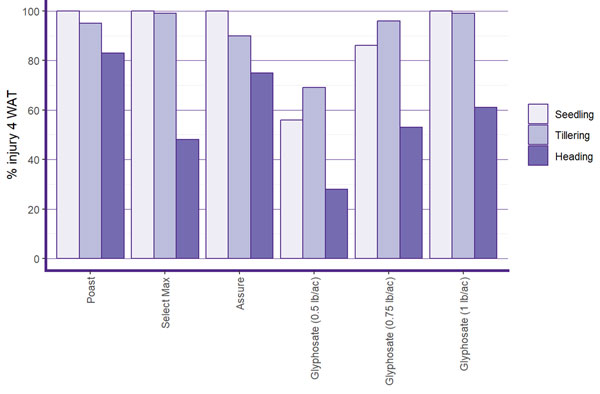Grass species such as tumble windmillgrass, tumblegrass, and purple three-awn are challenging to control when they have established a perennial stand. There is little information available for control of tumblegrass or purple three-awn. However, previous research showed that tumble windmillgrass can be controlled with timely and proactive preemergence and postemergence herbicide programs applied to seedlings up to the tillering stage.

Figure 1. Tumble windmillgrass plants growing in a corn field. Photo by Jeremie Kouame, K-State Research and Extension
Control improves when seedlings and plants are sprayed at the tillering stage
Previous greenhouse research (early 2000s) showed that four weeks after treatment (4 WAT), Poast, Select Max, and Assure caused 100% tumble windmillgrass mortality when applied to 2- to 4-inch tall seedlings and greater than 90% injury when applied to plants at the tillering stage (5 to 10 tillers per plant) (Figure 2). Tumble windmillgrass injury increased with increasing the rate of glyphosate1.

Figure 2. Tumble windmill injury 4 weeks after applications of glyphosate, Poast, Select Max, and Assure to seedling (2- to 4-inch tall), tillering (5 to 10 tillers per plant), and heading (when the first seed head is emerging) stages1.
Herbicide programs for tumble windmillgrass control
Field research (2001 and 2002) with preemergence and postemergence (applied to 1- to 2-inch tall tumble windmillgrass seedlings) herbicides in no-till corn showed that:
- All PRE treatments provided at least 90% control of tumble windmillgrass each year at 6 WAT.
- All POST treatments provided at least 90% control of tumble windmillgrass in both years by 6 WAT, with the greatest control provided by the sequential application of glyphosate in both years.
- All herbicide treatments provided 100% control of tumble windmillgrass at corn harvest, except alachlor + atrazine, for which tumble windmillgrass control was 89%1.
A more recent study, conducted over two years, showed that all tested postemergence herbicide programs applied to 10- to 12-inch tall tumble windmillgrass plants at the heading stage in fallow fields were ineffective and provided less than 68% control, except glyphosate which provided 85% control 28 days after application. In an ongoing on-farm trial (data not yet published), two applications of clethodim provided the best control of tumble windmillgrass in both no-till and minimum-tilled plots. However, tillage with a sweep plow provided enhanced control over no-till.
Strategic tillage
Implementing one-time strategic tillage with the sweep plow in long-term no-till plots showed a significant reduction in the density of purple three-awn and tumble windmillgass, the two predominant perennial grasses at the site. It can be inferred that strategic tillage would be effective for all three of these grasses since they are most problematic on long-term no-till acres. However, it is unclear how frequently strategic or occasional tillage of no-till fields is required to keep them free of these perennial grasses. Observations suggest that one tillage pass every three or six years in summer fallow ahead of wheat is likely adequate. Tillage should be implemented with a sweep plow equipped with pickers on a hot, dry day for the most effective control.
Timely controlled burns
For tumblegrass, grazing has limited effectiveness as a management tactic due to its unpalatable nature. However, practices that avoid overgrazing can aid in preventing the invasion of all three of these perennial grasses in rangelands. Tumblegrass is a fire-adapted species; thus, burning is also not likely to be an effective control strategy. With regard to purple three-awn, research from USDA ARS has shown that controlled burning can be an effective control strategy, with the greatest control from summer or fall burns.
The use of trade names is for clarity to readers and does not imply endorsement of a particular product, nor does exclusion imply non-approval. Always consult the herbicide label for the most current use requirements and follow all label instructions.
Sources:
1Hennigh et al. (2005), 2Dhanda et al. (2023), 3Obour et al. (2021)
Jeremie Kouame, Weed Scientist, Agricultural Research Center
jkouame@ksu.edu
Logan Simon, Southwest Area Agronomist, Southwest Research-Extension Center
lsimon@ksu.edu
Sarah Lancaster, Weed Management Specialist
slancaster@ksu.edu
Jeanne Falk Jones, Multi-County Agronomist
jfalkjones@ksu.edu
Patrick Geier, Assistant Weed Scientist, Southwest Research-Extension Center
pgeier@ksu.edu